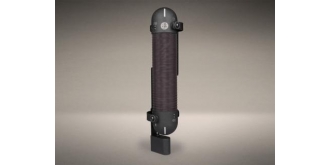 Agrandir l'image
Agrandir l'image
| Operating Principle: | Pressure gradient microphone |
| Directional Pattern: | Bidirectional (Figure-of-8) |
| Frequency Range: | 20 Hz to 20 kHz |
| Maximum SPL: | 165+ dBSPL (1% third harmonic > 1 kHz) |
| Output Sensitivity: | 2.5 mV/Pa (-52 dBV) into unloaded circuit |
| Output Impedance: | 270 Ω nominal |
| Recommended Load Impedance: | 1.2 kΩ or greater |
| Powering: | Not required or recommended |
| Polarity: | Pin 2 and 4 high for positive pressure on front of microphone. |
| Connector: | XLR-5M connector, includes breakout cable to 2x XLR-3M |
| Off Axis Response: | |
| Polar Pattern: | Native bi-directional pattern |
| Horizontal: | Level changes with angle, frequency response is consistent, –35 dB null at 90° / 270° |
| Vertical: | Level changes with angle, reduced HF response above and below 0° / 180° axis, –35 dB null at 90° / 270° |
| Transducer element: | |
| Ribbon Thickness: | 1.8 μ (0.0000018 m) of pure aluminum |
| Ribbon Width: | 0.185” (4.7 mm) |
| Ribbon Length: | 2.35” (59.7 mm) |
| Accessories: | |
| Included: | Custom storage / shipping case, manual, 12-foot breakout cable, swivel |
| Optional: | Any length cable, inquire for price and delivery. |
| Weight with Cable: | 5 lb 3 oz (2.36 kg) |
| Height: | 15” (38.1 cm) |
| Width: | 3” |
AEARMK507R
Nouveau
AEA -R88MK2

- Big Ribbon™ Blumlein (XY) and MS stereo ribbon mic
- Pure Ribbon™ design with open and natural sound
- Used in many Grammy Award winning projects
- Great foundation for main or sectional pickup
Being There in Stereo
In the 1930s, EMI engineer Alan Blumlein invented stereo recording by demonstrating the natural reproduction of the soundstage at one of the Abbey Road studios in London, UK. Still today, his coincident recording technique using two figure-of-8 ribbons is the benchmark for producing an authentic representation of a performance in a room. The R88 mk2 stereo microphone is a true Blumlein recording system optimized for recording instruments and ensembles in stereo. It utilizes two of AEA’s signature Big Ribbon™ elements angled at 90 degrees and mounted in close proximity to each other along the vertical axis of the microphone. The natural soundstage and character of the R88’s Blumlein stereo make it a great main mic. As an alternative to the Blumlein (XY) technique, the microphone can also be used for MS stereo, providing excellent mono compatibility and full control over the width of the stereo image. An excellent orchestral and choral recording microphone, it also shines on applications such as horn sections and drum overheads, thanks to the pure sound of two undamped long ribbons and the passive circuit without the headroom limitations of active electronics. The R88 accurately records complex tones such as woodwinds, strings, and cymbals. Whether it’s at Abbey Road or in your home studio, the R88 mk2 puts the listener right there with the performers in the recording room.
The Grammy-Winning Package
The list of Grammy and Academy Award winning projects recorded with the help of the R88 mk2 microphone is long and keeps growing: Turtle Island String Quartet, Los Tigres Del Norte, Juanes MTV Unplugged, Life Of Pi soundtrack to name but a few. The matched Blumlein pair of ribbons packaged in a sleek black shell designed for quick setup delivers a great sound right off the bat, making it an excellent choice for remote recording setups. As a drum overhead or room pick-up microphone, it instantly captures a punchy, “larger than life” image that is particularly well suited for rock, roots, Americana, and jazz genres. Seasoned engineers like Joe Chiccarelli, Chuck Ainlay or Vance Powell trust the AEA R88 mk2 so much that Nashville’s world-class Blackbird Studios now has an R88 available for every single room in their facility.
A Big Ribbon for a Big Sound
At the heart of the AEA R88 are two big, 2.35" by 0.185" by 2 micron pure aluminum low-tension ribbon elements just like the one used in the classic R44. Many ribbon mic manufacturers choose shorter ribbons that are easier to install, but AEA’s Large Ribbon Geometry™ design offers important advantages. Ribbon microphones operate linearly above their resonant frequency, unlike condenser or moving-coil transducers, so the resonant frequency of a good ribbon microphone design should be as low as possible. The longer the ribbon, the lower the resonant frequency will be. The ribbon has to move twice as far for every drop in octave as it vibrates within the magnetic gap, thus a longer ribbon will allow for further movement back and forth. This results in the ribbon handling louder sound sources and more sound pressure level (SPL). Most AEA ribbons are tuned to just 16.5 Hz, and because the R88 shares the same Big Ribbon™ as the rest of AEA's product line, you will achieve a sound that is smooth, natural and free from any of the uncomfortable resonances that shorter ribbons and condensers can exhibit. The result is a sound that many engineers say is astonishingly close to what their ears hear when they are actually standing in the studio.
The Minimalist Design Ribbons: R88mk2 Stereo Mic & NUVO N8
The minimalist designed R88mk2 Stereo Mic, and NUVO N8 capture the natural tonality of an instrument faithfully. Interposed with as little as possible between the source and the ribbon, the R88mk2 and N8 achieve an astonishingly open and natural sound that lets AEA’s famed Big Ribbon™ truly shine.By employing similar design materials, transducer model, and philosophy as used on the popular R88 Stereo Mic, the phantom-powered NUVO N8 features the same Big Ribbon™ technology that has earned AEA its reputation. The N8’s unobtrusive size makes it easy to position in tight situations or in venues where discreet placement is necessary. Its phantom-powered JFET electronics have made the N8 a mainstay on scoring stages and in project studios. With AEA's SMS Stereo Bar and NUVO Microphone Coupler, it is easy to arrange N8s in a precise and accurate Blumlein array. The R88 and NUVO N8 minimal internal blast protection facilitate a more open sound. Up-close use may result in substantial proximity effect so, for a natural bass to treble balance, sound sources should be feet rather than inches away. This also means you should be extra careful to avoid sudden blasts of wind. We recommend using a pop filter when using the R88 or AEA’s NUVO windscreens when placing the N8 or R88 closer than 6 inches away from a loud amp. The R88mk2 is not a stereo version of the R84. While the R84 and R88mk2 share the same ribbon and transformer, they were designed to have different tonalities.
Features And Specs
| Operating Principle: | Pressure gradient microphone |
| Directional Pattern: | Bidirectional (Figure-of-8) |
| Frequency Range: | 20 Hz to 20 kHz |
| Maximum SPL: | 165+ dBSPL (1% third harmonic > 1 kHz) |
| Output Sensitivity: | 2.5 mV/Pa (-52 dBV) into unloaded circuit |
| Output Impedance: | 270 Ω nominal |
| Recommended Load Impedance: | 1.2 kΩ or greater |
| Powering: | Not required or recommended |
| Polarity: | Pin 2 and 4 high for positive pressure on front of microphone. |
| Connector: | XLR-5M connector, includes breakout cable to 2x XLR-3M |
| Off Axis Response: | |
| Polar Pattern: | Native bi-directional pattern |
| Horizontal: | Level changes with angle, frequency response is consistent, –35 dB null at 90° / 270° |
| Vertical: | Level changes with angle, reduced HF response above and below 0° / 180° axis, –35 dB null at 90° / 270° |
| Transducer element: | |
| Ribbon Thickness: | 1.8 μ (0.0000018 m) of pure aluminum |
| Ribbon Width: | 0.185” (4.7 mm) |
| Ribbon Length: | 2.35” (59.7 mm) |
| Accessories: | |
| Included: | Custom storage / shipping case, manual, 12-foot breakout cable, swivel |
| Optional: | Any length cable, inquire for price and delivery. |
| Weight with Cable: | 5 lb 3 oz (2.36 kg) |
| Height: | 15” (38.1 cm) |
| Width: | 3” |





